How to Create a Suitable Pricing Model for a Business
Determining a pricing model for your business can be a challenge. Let's take a closer look at pricing models and how you can find the one that serves you...

Having a perfect product page is like having the best sales rep working to convert more visitors into customers 24/7. Creating a perfect product page can’t happen overnight, but there are many best practices to learn.
Many of these tips are based on trial and error and analytics. However, there will always be some elements that are unique to each industry and each company. That’s why perfecting your product pages is both an art and a science. Today, we’ll look at some of these best practices and share some examples to inspire you.
It's important to note that optimising your product pages can bring many benefits to your business. From a purely statistical perspective, you’ll see conversion rates go up. However, on a deeper level, you’ll also:
These topics will therefore come up again and again as we get into the nitty-gritty details of your product pages. You should also keep in mind that many of these benefits intertwine and impact each other. For example, having a better user experience will lead to longer browsing sessions, which boosts your search engine ranking, and consequentially, strengthens your brand image.
Here’s what you can expect to read about in this article:
Let’s start with something that you can begin today:
Product descriptions can be quite impactful to your product pages for a variety of reasons.
From an SEO perspective, having thorough, unique product descriptions can boost your page’s ranking in search engines. Many shops choose to use the manufacturer’s product description. Take this opportunity to focus on some relevant keywords and try to rank for those words by including them in your product descriptions.
From a brand perspective, you can also create unique content that really speaks to your audience. If you work in a niche industry, you might want to focus on particular industry terms to let users know your expertise.
From a user experience perspective, you’ll be able to inform your customers even more about what they can expect. Sure, ideally you’re convincing more visitors to become customers. However, you might also temper expectations and avoid users who might end up returning your product. A more informed customer is less likely to return products.
In the example below, Alpine Trek shares plenty of product specifications. Below the specs, the product description goes into detail about the technology used, the features it has, and even the suitable elevations for the jacket. It not only paints a picture for their target audience, but it informs them as well.
Click on the image to zoom in.
If you want to learn more about optimising product descriptions, make sure you check out our dedicated whitepaper:
Product images are another element that can boost the performance of your product pages.
From an SEO perspective, it’s quite similar to the reasoning behind product descriptions. Unique content, whether text or images, is loved by Google (and other search engines) and it helps improve your rankings in search engines. Be sure to use alt-texts in all of your images. This adds keyword relevance to the images and the page as a whole.
From a brand perspective, unique images help create a visual connection between your brand and your audience. By displaying images that strike a chord with your main demographic, you’re contributing to storytelling and strengthening the emotional connection people have with your brand.
From a user experience perspective, make sure you have high-quality, zoomable images, and plenty of them. Images inform your customers more, which reduces hesitancy (and returns). Show the product from many angles and show it in action. If you sell fashion items, include info on the model (height, weight, clothing sizes) in the product description.
Nomads Clothing has a very distinct style and they show this in the imagery across their entire website. Their product pages are no different. We see beautiful imagery with lots of detail. Each image can be clicked to zoom in so customers can see even more of the craftmanship that goes into their products.
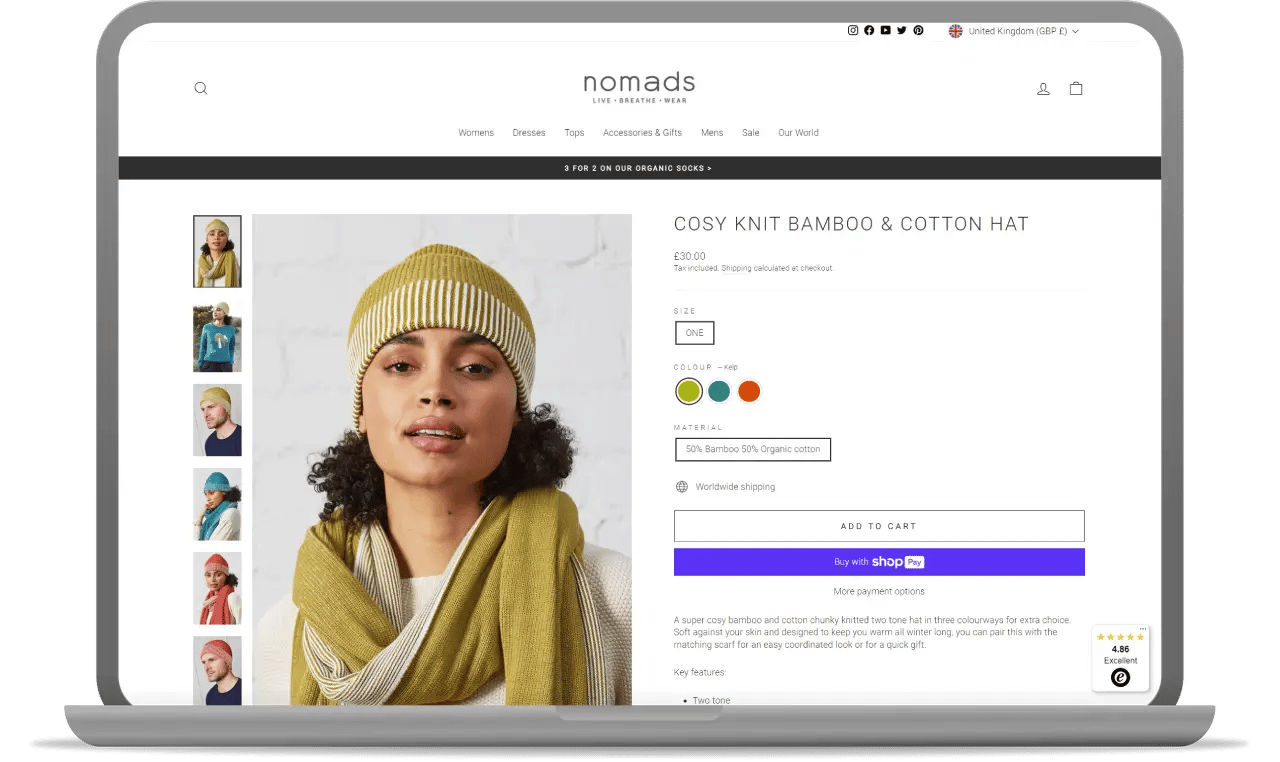
Design and the user experience go hand in hand. Much like each of the previous elements, many aspects of design and UX benefit the SEO and brand image of your company. Let’s take a deeper dive into some elements:
Page speed is more about being sleek than sexy. However, it’s an important part of design because it affects the user experience as well as the SEO of your product pages. Although design is super important, keep in mind that some compromises must be made when it comes to the SEO impact of your design. If your product page takes too long to load, people will leave before they’ve even technically entered.
The level of compromise will always be up to you, but use tools like Google’s PageSpeed Insights to see how your pages currently perform. It will also provide some suggestions for where you can optimise your pages.
This topic comes up again and again. In this day and age, you need to make sure your online shop is mobile-responsive. Not only are shoppers completing most of their purchases on mobile devices, but Google also uses the mobile variant of websites to crawl and determine page rankings. Mobile responsive brings huge benefits to your SEO, user experience, and brand image.
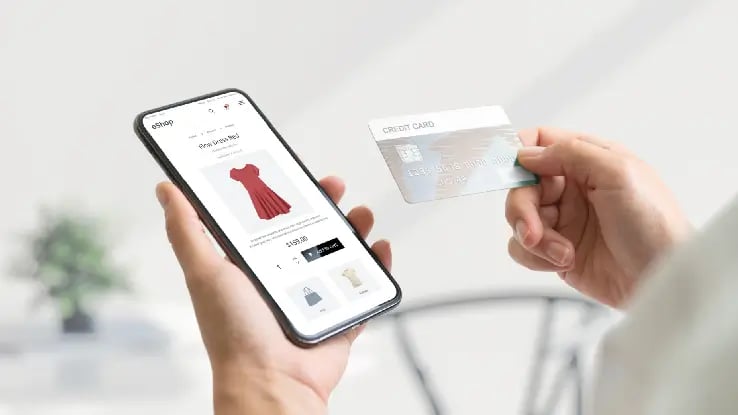
shutterstock/RSplaneta
Make sure your website is easy to use for new visitors. This can be harder than it seems. If you work at any company for a long time, it be can be difficult to understand an outsider’s perspective. If you think you can’t be truly objective, you may want to look externally for feedback. Focus groups can be helpful here.
When we talk about intuitive design and general layout, you should be thinking about things like:
From a user experience perspective, the context is obvious. You want users to be able to move about your website easily. If they can’t find their way around, if things are cluttered, if the design makes them uneasy or confused in any way, you’ve got to fix it.
Although it can be fun to be creative with your design, online shoppers have come to expect certain things in online shops. If you diverge too far from the norm, this could have a negative impact on the shopper.
It’s important to have a smooth shopper experience. Converting users on the product page is one thing, but being able to easily explore your website means potential higher shopping baskets. That’s how upselling and cross-selling strategies are relevant for the UX.
From a brand perspective, If the experience is smooth, easy, and pleasant, they’ll likely come back again and become a repeat customer. They're also more likely to recommend your shop to others.
From an SEO perspective, if the above-mentioned points for UX and branding are fulfilled, it will boost your site’s SEO. Think about it like this: if Google sees that a user jumps from their search results to your website, then after a few minutes, they visit 5 or 6 pages more pages on your site before completing their purchase, it’s a good sign. To Google, it says that the first page the user visited was relevant and therefore rewards you with an even better ranking.
In this example from Dotty Fish, the product page has a clean and simple, yet playful design – perfect for their target audience: young parents.
It includes access to the navigation, a search bar, the product rating, and breadcrumbs, all above the fold. When scrolling down a bit, product reviews can be read in detail, similar products are recommended, product details are expanded, and even a size guide for their adorable shoes is made available.
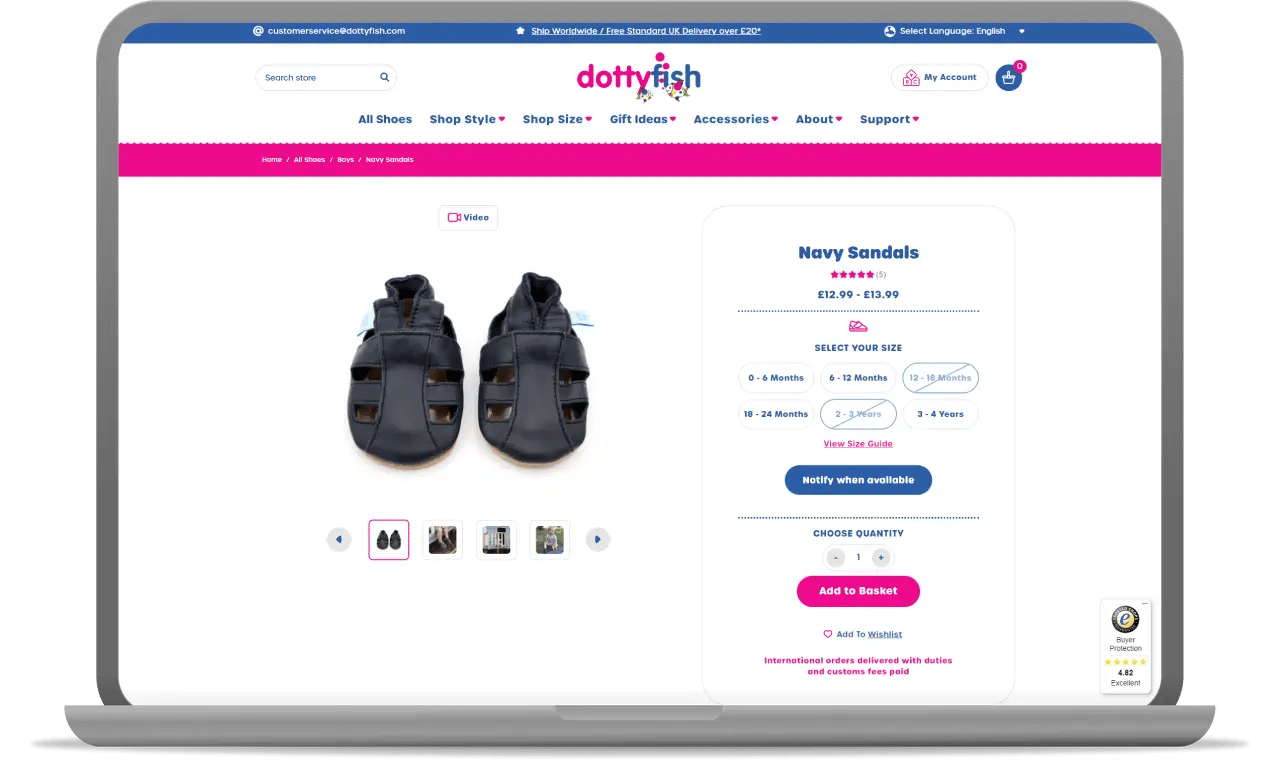
Last but certainly not least, a perfect product page has trust elements built in.
Many people think trust comes down to a feeling, but it’s actually a calculated risk assessment. Customers sometimes “go with their gut”, but usually they will look for a few trust indicators to help them decide. There are certainly a lot of things you can do to your product page to influence your trustworthiness.
There might not be a stronger trust-builder than social proof from fellow customers.
Customer reviews can be broken down into two categories:
Each should be treated a bit differently, but they do have a few things in common.
Naturally, including them in your online shop improves the user experience for obvious reasons.
Customer reviews can also bring an SEO benefit to your website. Product reviews impact product pages more while service reviews impact your domain as a whole. Relevant and fresh content on your product pages are good indicators for Google and help boost your ranking.
If you collect any type of reviews, it’s a good idea to work with a Google-certified reviews provider (like Trusted Shops). Being able to display stars in organic and paid search results can be a real game-changer when it comes to driving traffic to your site.
One more thing both review types have in common is that you should reply to them. Replying to reviews (both good and bad ones) can really show off your customer service. It can make a really good impression on shoppers (even more than having a perfect 5-star rating) and improve your brand image.
Product reviews are very relevant for product pages for obvious reasons. If a user is on your product page, the first thing they’ll want to learnabout is the quality of the product. Give users a reason to explore your page. In other words, don’t give them a reason to leave your page and do further research.
By displaying product reviews prominently, you’ll leave your page’s visitors with no doubts about your products. Much like product descriptions, product reviews inform users about your products in ways you might not have thought of. Indeed, it makes sense to keep an eye on your product reviews for inspiration when it comes to optimising your product descriptions.
Service reviews are also important for conversions. If other retailers sell the same product, service reviews can help differentiate you from your competitors.
Having trust on your side often allows you to win over customers despite higher prices. If pricing were the only factor in the purchase decision, shoppers would often rely on their feelings. Communicating your trustworthiness helps users make more confident decisions.
Every shop worth its weight in gold is happy to be contacted by potential as well as current customers. Make sure your contact info is easily found on your product pages.
Seeing a phone number alongside an email address or a chat window builds trust with users as well. Knowing they can pick up their phone or send a quick email to a human is reassuring to customers who’ve never visited your shop before.
Do you have a special returns policy? Overnight delivery options? Free shipping? Whatever else a customer might need to know before they complete their purchase should be seen on the product page. The key here is transparency. The customer shouldn’t be surprised by anything in the checkout process. All relevant info should be seen/known beforehand.
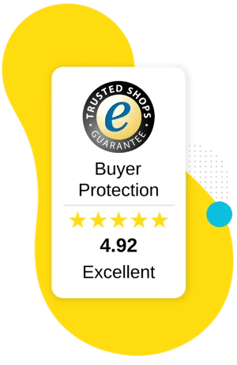 If you operate within a certain niche, certain certifications and seals hold special weight. A vegan shop has special certifications, as do gluten-free products. It doesn’t stop with food products. Fairtrade is a popular certification as well, especially in certain niches.
If you operate within a certain niche, certain certifications and seals hold special weight. A vegan shop has special certifications, as do gluten-free products. It doesn’t stop with food products. Fairtrade is a popular certification as well, especially in certain niches.
The Trusted Shops Trustmark with the 30-day Buyer Protection is suitable in many industries. As the most popular e-commerce trustmark in Europe, the Trusted Shops Trustmarkcan give new shoppers peace of mind when they see it. Knowing that they are protected for 30 days in case of non-delivery or refunds can give them the extra push to try out a new shop (your shop!) for the first time.
Learn more about the Trusted Shops Trustmark.
In the example below, Stikets displays product reviews on their page prominently: once right below the product name as a star rating, and then the individual reviews can be read further down the page.
They also showcase their service rating along with the Trustmark certification within the Trustbadge widget at the lower-right side of the screen.
Shipping info and payment methods are easy to find. A chat window is available while more contact methods are found in the footer. They do a great job building trust with their visitors.
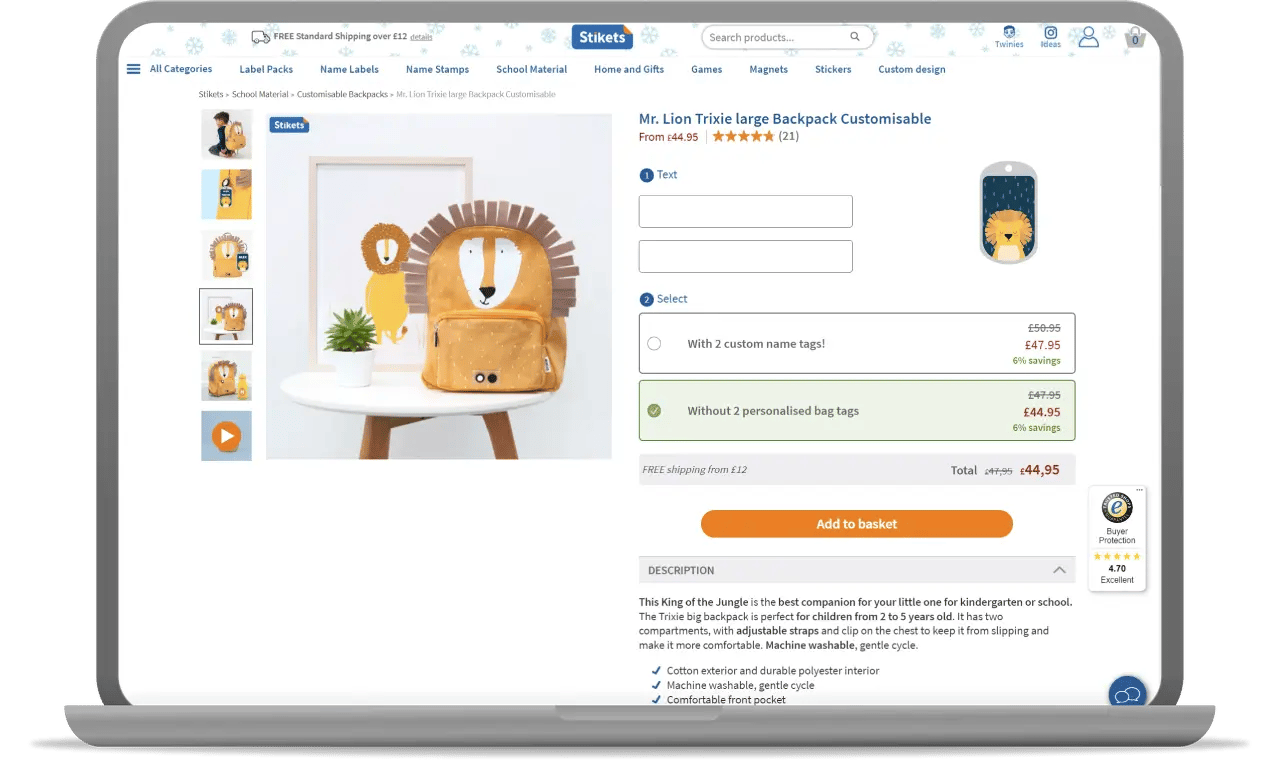
As we said in the intro, getting a perfect product page is part art and part science. Not every rule applies to every business in the same way. Some things take experimentation and simply require trial and error. Here are a few extra tips to consider when optimising your product pages:
Ensure that all your product page URLs are properly optimised for the keywords you are trying to rank for. Include a product number in there in order to keep all URLs unique.
You can also decide to mention the product version (for electronics) or size/colour (for fashion) in the URL itself.
With some smart URL creation tools in your backend, you can pretty much extract all the data automatically to generate these URLs.
Let’s look at an example of an optimised product page URL:
The benefit of such an approach is that your website can immediately compete for a large number of keywords at the URL level itself, so there is a big SEO benefit here.
A/B tests are a way of blending the art and science of running an e-commerce business. Be creative and experiment with some things, but use data to be objective about your decisions. Often, it’s not the most creative idea that wins.
Again, we’re coming back to the science element (or at least the mathematics part). As is the case with any attempts to optimise your online shop, keeping track of performance is important to gauge your success. Let the numbers guide you. Make sure you know your key performance indicators (KPIs).
If you run any kinds of ads to drive traffic to your product page, it’s definitely worth checking on your campaigns regularly.
Are your ads losing their luster? Maybe you need a new image or a new headline.
If you run Google Ads, make sure you are displaying your star ratings in your ad extensions.
Other than that, take a look at your keyword strategy. Are you using effective targeting. Do you know about negative keywords? What about long tail keywords? These can help drive down the costs of your ads while also eliminating unwanted (i.e. low-converting) traffic.
Speaking of Google, it’s important to investigate the entire customer journey, from Google Ads to the checkout process.
There are a lot of things to check, but you should make sure all your dots are connecting as smoothly as possible. Is the flow of the journey logical? Are there any breaks in between that can be eliminated? Are you asking for too much information in the checkout process? Are you losingcustomers because they are forced to create an account before completing their purchase?
These are just some of the questions you can ask yourself as you go through the customer journey.
Product pages are there not only there to display your products, but they are also meant to convince users to buy the product from you. By tweaking your site to be transparent, inform customers, and build trust, you’ll surely see your conversion rates grow in no time.
To learn how Trusted Shops can help your online shop convert more by building trust, visit our B2B homepage or download our product overview:
31/01/24Determining a pricing model for your business can be a challenge. Let's take a closer look at pricing models and how you can find the one that serves you...
With Father’s Day approaching, it’s time to think about promotions and sales. What can small businesses do to boost their sales for the upcoming holiday?